For years the mining industry had to make do with staff transport vehicles that were frankly not up to the job. Today, there is a much wider choice of robust, custom-build carriers.
By Simon Walker, European Editor
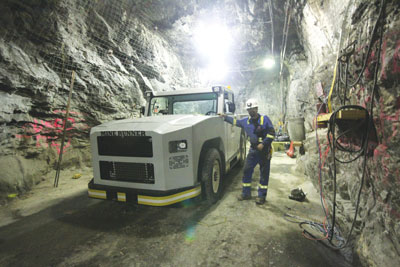 BTI’s Mine Runner has no vulnerable mechanical components underneath, so can handle rough road conditions.
BTI’s Mine Runner has no vulnerable mechanical components underneath, so can handle rough road conditions.Since beginning a second career in mining writing some 30 years ago, my experiences with mine-site personnel transport have, to say the least, been very varied. Indeed, until relatively recently, most of the vehicles that I have ridden in—both underground and in open-pit mines—have either been standard ‘off-the-shelf’ pickups or vans that have been derived from other standard designs. Even the humble agricultural tractor has been modified to carry miners and writers alike, while the experience of being transported along rough underground haulages in what was essentially a people cage on a wheel-loader is probably best forgotten. At least, the location is, if not the ride.
In the 1980s and 1990s, the one general exception to all of this was found when visiting mines in Eastern Europe. Here, the cross-over between mining and military hardware meant that rugged troop-carriers and Lada 4×4s were in common service, and although mechanical reliability and aesthetic design may not have been their strong suits, at least the vehicles were physically tough enough to withstand the conditions.
Not so elsewhere, where mining companies essentially had to make do with whatever their local pickup dealers had to offer. And, to be honest, that was often not much. True, the individual vehicles were cheap enough, but they were designed for the working conditions experienced by tradesmen and farmers, not miners. There’s a big difference, and standard trucks don’t have long lives when being used for exploration and mining duties.
That there was a gaping niche in the market was obvious to everyone involved, including company accountants, yet vehicle manufacturers were not exactly quick off the mark in providing suitable solutions. One big problem was unit cost, with those same accountants reluctant to shell out substantial sums for custom-built carriers when cheaper alternatives were readily available. And the other was the design cost itself, with manufacturers cautious about investing in design engineering for products that would clearly have only a limited market.
Still, some farsighted companies did take up the challenge, and today’s mine manager now has a much wider range of options from which to choose. Some suppliers have gone down the route of producing combi-type utility vehicles that can be equipped with different load carriers depending on the job on hand. Versatility is the selling point here, with the same power unit available to handle, for example, materials transport or a scissor-lift platform or personnel, as required.
Another approach has been to take existing standard designs and make them stronger, as well as adapting engines to suit underground emissions requirements. A major benefit here is that most spares will be readily available from local dealers, since the basic chassis is an ‘off-the-shelf’ product.
And finally, there are those manufacturers who have analyzed the challenge in depth, and have come up with a new generation of people-carriers that are designed specifically to handle the physical mine environment. Heavily built, and often with a fairly minimalist approach to design, they offer the ultimate in durability when driving conditions are tough and roadway surfaces are rough. There is, of course, a quid pro quo here: built-in durability carries a substantial cost premium over the lighter-weight alternative.
In the end, it all comes down to the individual company and how it perceives the best way to spend its money. Mine operators, service companies and contractors will each have different criteria.
What is essential? To get personnel to and from their workplaces reliably every shift, and to provide supervisors and tradesmen with the flexibility that they need to move around an operation. There are now more options than ever before.
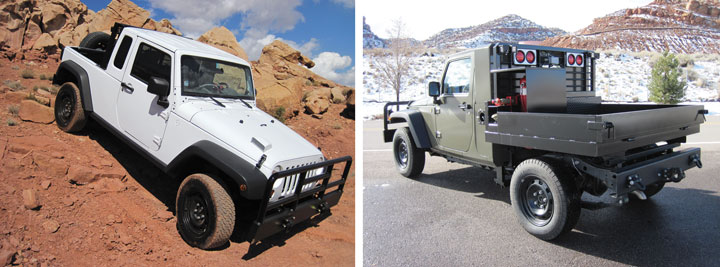 Utah-based Classic Motors Inc. offers both Ram and Jeep 4×4s—including the Jeep J8—modified to meet underground min
Utah-based Classic Motors Inc. offers both Ram and Jeep 4×4s—including the Jeep J8—modified to meet underground minCustomized Rams and Jeeps
Utah-based Classic Motors Inc. (CMI) has over 20 years’ experience in modifying standard U.S.-produced vehicles for use underground, citing conversions of the heavy-duty Ram and Jeep J8 pickups as being its core products.
Last year, the Chrysler group announced the production of a version of its Jeep J8 specifically for underground mining, for sale exclusively in the North American market. Equipped with an Italian-built, 147 kW (197 hp) 2.8 liter turbo diesel engine, the underground J8 has a five-speed automatic transmission and four-wheel drive. The engine is approved by both MSHA and CANMET for use in both hard-rock and coal mining underground.
CMI reports that it can provide mining-grade vehicles based on the J8 in both two- and four-door formats, offering payloads of up to 1.2 mt (2,566 lb). Its Ram and J8 conversions can provide carrying capacity for up to 10 people and, in the case of an emergency, can also provide stretcher transport.
The company notes that converting standard vehicles to meet MSHA and CANMET underground specifications involves a raft of modifications to both the fuel and electrical systems, as well as the installation of a fire suppression system. Included in the package is upgrading and protecting the truck’s fuel lines, installing protection beneath the fuel tank and installing a manual fuel shut-off valve. The engine control system is also adjusted to derate the engine to meet regulatory standards.
For the electrical system, cable harnesses that are potentially vulnerable to damage need to be re-routed through conduits, while all connections have to be sealed to reduce the potential for corrosion. A master switch is fitted to enable the power to be turned off if needed, with a special circuit that will shut down the engine should the fire-suppression system be activated.
The Unbreakable from BTI
From Canada, Breaker Technology Inc. (BTI) offers underground mines with two options for personnel transport: its MPV multi-purpose vehicle cassette system, and the Mine Runner all-purpose vehicle. As the name suggests, the MPV features a common, center-articulated chassis on which a range of task-orientated cassettes can be mounted, including one for personnel. This has steel enclosed sides and provides two rows of padded bench seating, with customized deck sizes available.
BTI describes the Mine Runner as being “a modern-day solution for a future-focused mining operation,” being neither a customized road vehicle or a generic people carrier. Powered by an MSHA/CANMET-compliant 3.6-liter Deutz engine, it has hydraulic wheel drive motors, providing greater power, and extended maintenance and duty cycles, the company says.
The braking system also operates through the drive motors and pump, so there are no brake pads to wear out or replace, while the use of hydraulic drive means that there are no vulnerable mechanical drive components beneath the vehicle. Measuring 6.2 m (243 in.) long and 2.2 m wide in personnel carrier configuration, the Mine Runner has 318 mm (12.5 in.) of ground clearance and 180 mm (7 in.) of suspension travel, allowing it to negotiate seriously rough roadways.
The three-seat driver’s cab comes equipped to ROPS/FOPS standards, which can also be applied to the rear personnel unit if required. Looking nothing if not solidly built, the Mine Runner weighs in at 4.5 mt (10,000 lb) unladen, and can handle a 1.8 mt load at speeds of up to 40 km/h (25 mph).
Designed Tough for Underground
With three personnel-transport options within its utility vehicle product portfolio, Normet can supply both center-articulated and conventionally steered carriers for underground mines. The Utimec 6160 Per is a dedicated, 16-man personnel transporter for use in haulages that are at least 2.4 m (8 ft) high, with seating for a driver and one other in the cab, and 14 more on benches in the rear compartment. Both Deutz and Daimler Tier 3-compliant engines can be fitted, providing a top speed of 25 km/h. The driver’s cab is built to RPOS/FOPS standards, and both this and the passenger compartment are sound-proofed.
Meanwhile, Normet’s C162 personnel cassette is designed to be used in conjunction with the Multimec 6600 and MF 100 multipurpose carriers, offering bench seating for 16 people.
Having seen that vehicles that have not been specifically designed for underground use rarely last long, Normet has come up with the RBO which, it claims, is the ultimate underground vehicle—robust, safe and powerful while being as comfortable as an SUV. The RBO’s four-door cab has room for five people, while the open cargo bed behind has a 1-mt carrying capacity.
Caterpillar or Deutz 95 kW engines are available, driving an electronically controlled automatic hydrostatic transmission, while the braking system includes two-circuit oil-immersed multidisc service brakes and a fail-safe parking/emergency brake.
While the vehicle features heavy-duty construction, weighing 4.25 mt unladen, it is also equipped for operator comfort, Normet points out, with the cab including sound insulation, heating and air conditioning, a laminated safety windscreen and halogen headlights, all designed to handle underground conditions.
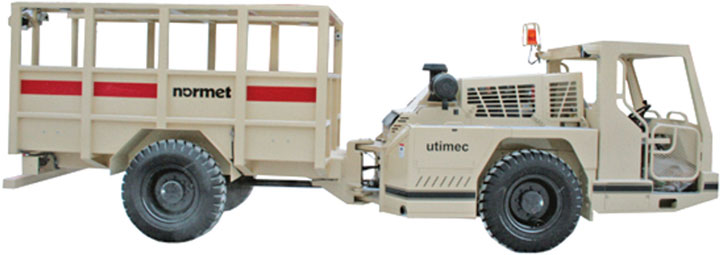 Normet’s Utimec 6160 Per is a dedicated center-articulated, 16-person carrier.
Normet’s Utimec 6160 Per is a dedicated center-articulated, 16-person carrier.Minecat: Diesel or Battery Power
Also from Canada, Industrial Fabrication Inc.’s Minecat UT99 offers up to nine seats (including the driver) in its personnel transporter form. Power from a 3.3-liter Cummins QSB 3.3 engine is transmitted through a Dana power-shift drive system that gives four forward and three reverse gears, providing a top loaded speed on the flat of 35 km/h (22 mph).
Seating layout depends on the vehicle configuration: with a two-door cab, the rear-mounted personnel enclosure holds six, while the smaller unit fitted behind a chassis with a four-door crew cab adds an extra three or four seats to the five up front. In all, the company offers six different mantrip options, including a casualty evacuation version for carrying a stretcher.
It may look much the same from the outside, but the Minecat UT150-eMV is what the company claims is the industry’s first purpose-built, hard-rock mining electric mine vehicle—as well as being the safest utility vehicle in the industry. The running gear is the same as on the diesel-powered UT99, using proven industrial axles with fully enclosed fail-safe wet disc brakes, while the mining-grade suspension features heavy duty gas shock-absorbers and springs.
The drive system consists of a zero-emission PMAC brushless traction motor, with all the main electrical components sealed to IP67 rating to allow the vehicle to operate safely in the most severe mine conditions. Located under the vehicle’s bonnet in place of the diesel engine, the lithium iron phosphate battery pack provides a range of up to 70 km (44 miles) on the flat when the vehicle is fully loaded, or up to 14 km (9 miles) on a 20% incline. An additional battery pack can be fitted to extend the range or duration between charging cycles.
Industrial Fabrication notes that the diesel UT99 and electric UT150-eMV have the same vehicle weight and rear cargo space, so can be fitted out in any of the company’s standard or custom user configurations.
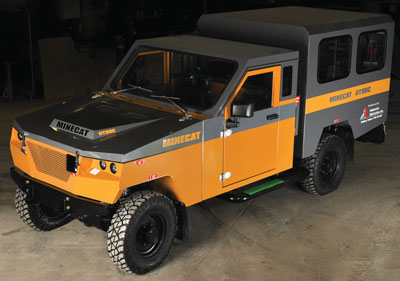 One of the body options for the Minecat UT99, with an enclosed six-man compartment.
One of the body options for the Minecat UT99, with an enclosed six-man compartment.Converted for Extra Safety
From its headquarters in a suburb of Brisbane, Queensland, Minecorp is not an OEM of personnel carriers, but it does specialize in converting standard vehicles to the much higher safety standards that the mining industry requires.
According to Minecorp, because light commercial vehicles, 4×4s and SUVs have a higher center of gravity, they are much more susceptible to rolling over in an accident than other passenger vehicles in normal conditions. Operating in harsh environments heightens the incidence of roll-over, the company adds. In fact, research into accident involvement patterns has shown that you are twice as likely to roll if you drive a 4×4, and 3.4 times more likely to die as a result of a roll-over, Minecorp states.
Its M-Pass solutions come in three grades—essentials, industry and endurance—depending on the level of risk and the industry where the vehicle is used. Not surprisingly, mining and exploration are at the top end of the list. M-Pass Endurance is designed for harsh environments and remote travel applications, with the package covering all emergency equipment including communication, visibility and electrical requirements.
M-Pass modifications are available for selected vehicles made by Toyota, Nissan, Mazda, Mitsubishi, Ford and VW, and cover single cab, crew cab, personnel carrier and minibus body styles. The addition of four- or six-point ROPS cages is just the starting point, with a whole range of lighting, communications and functionality upgrades available as well. Even more important for open pits, improved vehicle visibility options include beacons, whip aerials, reversing alarms, and safety and identification decals.
Aside from its operations in Australia, the company services the mining and exploration industries internationally with branches in Chile and South Africa, and through agents in Papua New Guinea, Laos, Mongolia, Tanzania and Zambia.
Mine Cruiser from Down Under
Designed for transporting crews to and from the face in Australia’s coal industry, GE Mining Industrea’s Mine Cruiser is powered by a 4.3-liter, four-cylinder diesel engine that features a number of safety modifications that permit the vehicle to operate underground. With industry regulations require external surfaces to stay below 150°C, the engine incorporates spark arresters while the exhaust manifold is encased in a water jacket to provide surface cooling. In addition, the exhaust gas is routed through a water bath for further cooling and particulates scrubbing—with the gas exiting at no hotter than 77°C, the company states.
As an option, the engine can also be fitted with an advanced shut-down system that is activated if a higher than permissible concentrations of methane are detected.
With over 500 units sold to date, the Mine Cruiser is 6.4 m (21 ft) long and 2.1 m (7 ft) wide, weighing in at 5.4 mt unladen. Ground clearance to the chassis is 330 mm (13 in.). It has a 1.2-mt load capacity, and can provide seating for up to 11 people front-and-rear facing, or 12 with side-facing seats. The passenger compartment roof is designed to ROPS/FOPS standards, with additional protection available as an option.
Mobility for Tough Conditions
According to the German manufacturer, Paus, its MinCa utility vehicle has been designed specifically to work in extremely difficult mining conditions and in tunnels as narrow as 3.7 × 3.7 m (12 × 12 ft). Equipped with all-wheel-drive and a suspension system that ensures that all four wheels remain in contact with the ground, the MinCa provides good maneuverability and driver comfort, as well as being very versatile, Paus adds.
Capable of carrying a payload of up to 3.8 mt, the MinCa is available in a number of different versions with different fixed cassettes, including a personnel transporter with a capacity of up to 18 people. Power comes from a 90-kW Deutz water-cooled engine. The company notes that the high-torque hydrostatic drive and unique suspension principle with high ground clearance are all major benefits, guaranteeing maximum speeds even on extremely poor road surfaces or inclines. The MinCa is also available with all-wheel steering to enable it to operate in extremely confined haulages, and the driver’s cab is designed to hinge forward to provide better access for engine maintenance.
Paus’s’ second option for moving people underground is the 12-man personnel carrier version of its Universa 40, which is available in either a fixed configuration structure or as a ‘quick-change’ model. Center articulation gives it the vehicle even better maneuverability than the MinCa, being able to operate in haulages as little as 3.25 m wide.
Paus told E&MJ that all of its vehicles have a spacious driver’s position, from where the driver has an excellent view of the vehicle and all its controls. Cabs are ROPS/FOPS-tested and feature a display for analyzing key vehicle data or error messages. All its machines also feature an SAHR braking system, while the company’s Power Drive system provides overspeed protection when travelling down inclines.
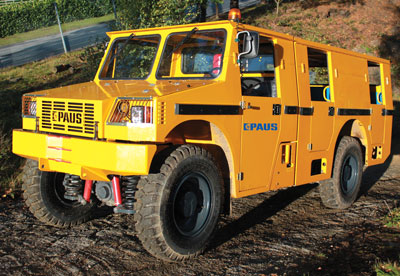 The MinCa from Paus has a 3.8-mt payload, and can carry up to 18 people.
The MinCa from Paus has a 3.8-mt payload, and can carry up to 18 people.Taking Bigger Crews Further
One consideration for any company contemplating buying a new people carrier is clearly the numbers that need transport, and the distance involved. It is no use buying a seven-seat vehicle if it has to make two journeys to move the whole team, for instance. Hence there is a market for larger vehicles, and where there is a market, manufacturers are not so far behind these days.
Maclean Engineering’s Mine-Mate PC3 personnel carrier is available with the capacity to take from 14 to 22 miners to their worksite and back, and can also be adapted as an auxiliary transport vehicle. The company says that it has been designed specifically for use in trackless mines where large crews travel long distances to work places from shaft stations, and for moving people from surface to multi-level destinations via mine ramp systems.
The PC3 is purpose-built for underground, not a converted surface vehicle, with a rugged design for maximum durability, the company told E&MJ. It has an empty weight of 12.7 mt (28,000 lb) and, at 8.8 m (28 ft 9 in.) long and 2.3 m (7 ft 6 in.) wide, it certainly dwarfs some of the other vehicles available. Centre articulation gives a 6.5-m inside turning radius, with the driver sitting sideways on the drive unit, as in an LHD.
Maclean claims that the use of proven power train components ensures a long life, while the fuel-efficient engine installed minimizes harmful emissions. Electronic engine diagnostics, and accessible fuel filling and grease points simplify maintenance.
Both the driver’s position and the passenger area can be provided open, with ROPS/FOPS canopies, or with a fully enclosed driver’s cab.
A MUTT with a Pedigree
With its production facilities in Abingdon, Virginia, USA, Damascus Corp. has been producing people carriers for the mining industry since the 1980s. Its initial product range of three-wheel, battery-powered vehicles was soon supplemented by larger carriers with greater capacity, with the company then moving into diesel powered vehicles as well. In 2013 it launched its most recent innovation, the diesel MUTT, which is designed to carry up to 12 people in coal roadways that are at least 1.8-m (6-ft) high.
The Mining Underground Transport Truck (or MUTT for short) has 460 mm (18 in.) of ground clearance and an overall height of 1.77 m (69.5 in.). Power is provided by an MSHA-approved, rear-mounted 115-kW (155-hp) Cummins QSB 4.5 engine, and a hydrostatic drive. This provides easy access for maintenance and provides weight over the rear wheels to improve traction, Damascus points out.
A big benefit is that the MUTT has automotive-style controls that make it easy for new operators to learn how to drive it. Rear cameras eliminate the need for mirrors, and the vehicle has hydrostatic braking, enclosed front and rear wet disc brakes and LED lighting. An enclosed cab with climate control is standard, with options including ROPS and FOPS protection and four-wheel drive.
Standard travel speed is 18.5 km/h (11.5 mph), although a top speed of 40 km/h (25 mph) is achievable. A manually actuated Ansul fire suppression system with engine shutoff is standard on the MUTT, with an automatic system also available.
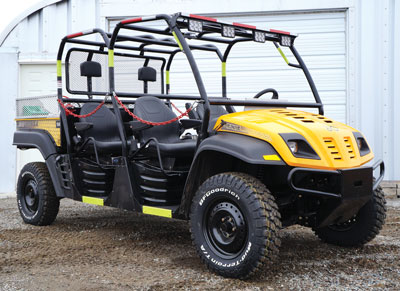 MSHA-approved for coal-industry use, Damascus Corp.’s MUTT can carry up to 12 people.
MSHA-approved for coal-industry use, Damascus Corp.’s MUTT can carry up to 12 people.Self-contained, or Towed?
Based in Nigel, South Africa, NCS Engineering has built personnel transporters for the mining industry for the past ten years. The company has also developed a 20-seat personnel transport trailer that can be used by mines with their own tow vehicles. This increases their plant utilization and offers a cheaper alternative to getting personnel to their place of work, the company points out.
NCS’s standard 18-seat personnel carrier uses a 48 kW Cummins naturally aspirated diesel engine to power a hydrostatic drive system. The carrier itself is 6.6 m long and just under 2 m wide, with an unladed weight of 3.45 mt.
A failsafe braking system is standard, with 186 mm of axle differential ground clearance and 352 mm of hump ground clearance. The passenger and driver compartments are ROPS/FOPS certified.
The vehicle can achieve a speed of 18.5 km/h on the flat, or 8 km/h on a 15% incline. Options include a fire-suppression system, mechanical engine protection, an electromagnetic door-locking system, and a speed control system including a display and control box with driver vigilance monitoring.
Small and Speedy
According to Canadian company, United Personnel Carriers (UPC), there has always been a need for small utility/personnel carriers underground, with the company having been founded in 2008 on the basis of building a lower operating cost per hour vehicle than any other similar utility/personnel carrier on the market.
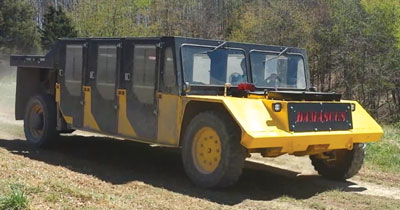 With seating for four, the UPC Shifter is designed for supervisor and tradesman transport.
With seating for four, the UPC Shifter is designed for supervisor and tradesman transport.UPC takes CubCadet Volunteer recreational utility vehicles and converts them into units that are suitable for mine supervisors and tradesmen to use. Both two- and four-seat versions are available, as well as a vehicle that can travel on both tires and rails.
The conversion to the Shifter 4×4D involves upgrading the braking system to SAHR, installing a long-life CVT system, heavy-duty LED lights, fire-proof wiring and sealed controls, amongst other modifications. The machine is powered by a Tier 4-compliant, 16 kW (22 hp) Yanmar diesel engine, with permanent four-wheel drive. Its carrying capacity is 360 kg (800 lb), with the passenger compartment protected by a roll-over cage and by mesh panels around the rear seats.
Despite its operating weight of just 750 kg for the two-seat version, or 890 kg for a four-seater, the vehicle still offers 280 mm of ground clearance for use on rough underground haul roads. And the top speed? 20 km/h.









